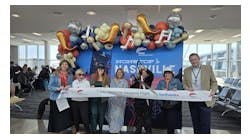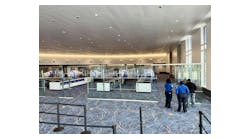Syracuse, N.Y. — Landing gear down, seat trays up and locked, Sandy Williamson’s flight from Detroit was about to touch down in Syracuse when, suddenly, it was not.
“We’re coming down, we’re coming down and then all of a sudden, we just went right back up and, swish, it was really fast,” said Williamson. “A few minutes went by and the pilot said, ‘Unfortunately, we can’t land in Syracuse and we don’t know where we’re headed.’ ”
The Delta flight on April 29 wound up diverting to Kennedy Airport in New York City for the night. Williamson, who is from Detroit, said she stayed with her brother in Manhattan for the night, then took a Delta flight the next morning to Syracuse, where she is visiting a friend.
She said many people on the flight from Detroit were upset.
“For a lot of people, it was a huge inconvenience,” she said. “I was bummed.”
The problem? Low clouds and the recent shutdown of Syracuse Hancock International Airport’s main runway for an upgrade.
Such diversions are a rarity at the airport, which has a reputation of staying open no matter the weather, even during the area’s notoriously brutal winters. But they have happened at least three times since the airport’s main runway was shut down April 28.
Planes will have to use the airport’s secondary runway while the main runway’s asphalt is replaced and new, LED lights are installed. The project is scheduled to last through Sept. 28, 2021.
Landing on the secondary runway is not a problem in good weather, but it can be a challenge during bad weather.
Both runways at the airport have systems that emit radio signals that help guide planes down when visibility is poor. But there’s a difference between the systems on each runway.
The main runway has an advanced instrument landing system, or ILS, that helps to not only line up planes with the runway, but also keep them on the proper glide slope as they descend.
The secondary runway, on the other hand, has a less advanced system that helps line up planes with the runway but does not guide their descent.
Airport Director Jason Terreri said it is not unusual for an airport’s secondary runway to have a less sophisticated ILS than that of the much more frequently used main runway. The FAA, which installs and maintains them, decides which runways get which systems, he said.
With either system, pilots must at some point see the runway before deciding whether to land or go around. At Syracuse’s airport, the “decision height” is 200 feet above the ground for approaches from one side of the main runway and 150 feet from the other side.
But pilots must be able to eyeball the runway from 250 feet up when approaching from one side of the secondary runway and from 300 feet high when approaching from the other side.
That’s why flights have diverted from Syracuse with more frequency lately. Terreri said several days of cloudy weather meant that some planes did not have the minimum visibility needed to land on the secondary runway, landings they likely could have made if the main runway was open.
Terreri said pilots have the option to go around as many times as they wish to look for a break in the clouds and attempt another landing. But, depending on how much fuel their aircraft has left, they may decide to divert to another airport and wait for the weather to clear in Syracuse, he said.
Depending on the airline, they could divert to someplace close like Rochester, but they may also divert to places as far away as Detroit or New York City, where the airline may have more crews and planes available to eventually get passengers to Syracuse, Terreri said.
“This is something pretty common in our industry,” he said. “It’s just not something that everyone in Syracuse is used to dealing with.”
Neither the airport nor the Federal Aviation Administration keeps data on flight diversions. But Terreri said it does not happen often in Syracuse.
“In the summer months when you’ve got storms, you may have one, maybe two episodes where you have a diversion, but then we’ll go five months without a single diversion,” he said.
Syracuse, with its 9,003-foot main runway, the longest in Upstate New York, is often the place where planes headed to other airports in the Northeast divert to when the weather is bad at their destination.
“We’re the diversion airport,” Terreri said. “We get diversions all the time from Watertown, anything going into New York, Philly, Boston, because we’re on the way. They see they’re socked in, so they divert to Syracuse. We’ve had flights from London land here and then wait to get into JFK.”
Rick Moriarty covers business news and consumer issues. Got a tip, comment or story idea? Contact him anytime: Email | Twitter | Facebook | 315-470-3148
©2021 Advance Local Media LLC. Visit syracuse.com. Distributed by Tribune Content Agency, LLC.


